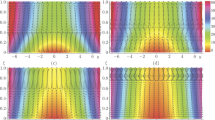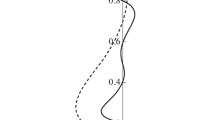Abstract
The principal characteristics of thermocapillary convection in a rectangular channel with one of the boundaries heated to a temperature higher and the other to a temperature lower than T0 are investigated numerically on the basis of the Navier-Stokes equations. Certain convection characteristics corresponding to normal and anomalous thermocapillary effects are qualitatively compared. The conditions under which self-similar solutions of the type obtained in [10] can be used to describe the flow in a bounded region are determined.
Similar content being viewed by others
Literature cited
R. Vochten and G. Petre, “Study of the heat of reversible adsorption at the air-solution interface,” J. Colloid Interface Sci.,42, 320 (1973).
P. J. Desre and J. C. Joud, “Surface tension temperature coefficient of liquid alloys and definition of a “zero-Marangoni number alloy” for crystallization experiments in microgravity environment,” Acta Astronaut.,8, 407 (1981).
J. C. Legros, M. C. Limbourg-Fontaine, and G. Petre, “Influence of a surface tension minimum as a function of temperature on the Marangoni convection,” Acta Astronaut.,11, 143 (1984).
M. C. Limbourg-Fontaine, G. Pétré, and J. C. Legros, “Texus 8 experiment: effect of a surface tension minimum on thermocapillary convections,” Physicochem. Hydrodyn.,6, 301 (1985).
M. C. Limbourg-Fontaine, G. Petre, and J. C. Legros, “Thermocapillary movements under microgravity at a minimum of surface tension,” Naturwissenschaften,73, 360 (1986).
D. Villers and J. K. Platten, “Marangoni convection in systems presenting a minimum in surface tension,” Physicochem. Hydrodyn.,6, 435 (1985).
V. V. Pukhnachev, “Development of an anomalous thermocapillary effect in a thin liquid layer,” in: Hydrodynamics and Heat and Mass Transfer for Flows with a Free Surface [in Russian], Novosibirsk (1985), p. 119.
V. V. Pukhnachev, “Thermocapillary convection in weak force fields,” Preprint No. 178–188 [in Russian], Institute of Thermophysics, USSR Academy of Sciences, Novosibirsk (1988).
D. Villers and J. K. Platten, “Separation of Marangoni convection from gravitational convection in earth experiments,” Physicochem. Hydrodyn.,8, 173 (1987).
Yu. I. Gupalo and Yu. S. Ryazantsev, “Thermocapillary motion of a liquid with a free surface in the presence of a nonlinear dependence of surface tension on temperature,” Izv. Akad. Nauk SSSR, Mekh. Zhidk. Gaza, No. 5, 132 (1988).
V. I. Polezhaev, A. V. Buné, K. G. Dubovik, et al., Mathematical Modeling of Convective Heat and Mass Transfer on the Basis of the Navier-Stokes Equations [in Russian], Nauka, Moscow (1987).
A. Zebib, G. M. Homsy, and E. Meiburg, “High Marangoni number convection in a square cavity,” Phys. Fluids,28, 3467 (1985).
Author information
Authors and Affiliations
Additional information
Translated from Izvestiya Akademii Nauk SSSR, Mekhanika Zhidkosti i Gaza, No. 1, pp. 138–143, January–February, 1991.
Rights and permissions
About this article
Cite this article
Dubovik, K.G., Slavchev, S.G. Numerical modeling of thermocapillary convection in a liquid layer with a nonlinear dependence of the surface tension on temperature. Fluid Dyn 26, 114–119 (1991). https://doi.org/10.1007/BF01050122
Received:
Issue Date:
DOI: https://doi.org/10.1007/BF01050122




